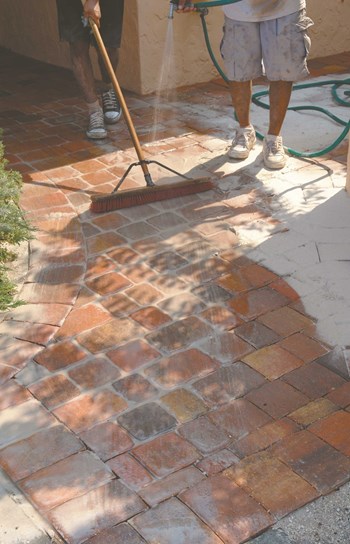
Landscaping is a vital part of an association’s curb appeal and a driving force in attracting new residents to live there. When most people think of landscaping, they think of dew-covered green lawns, shrubs and trees, meticulously maintained flowerbeds and artful plantings scattered around a building or development.
But live vegetation isn’t the only hallmark of a beautiful property. An association can create an outdoor oasis with walking paths, fountains, statues, rock gardens, patios, terraces and decorative wall elements. Otherwise known as ‘hardscaping,’ this approach encompasses any non-plant-related landscaping. While some associations just use greenery, others are committed to a hardscape-only property. Still others use a combination of both.
Form & Function
Forgoing the foliage and decorating a property with properly placed rocks and paving stones can not only look beautiful, but these designs are also extremely functional. First, they may be used to correct any potential land problems with the property. For example, building a fence or wall can function as a windbreak, and a walkway may be used where grass would be worn down due to constant foot traffic. Other hardscape features, such as a fountain or patio may be more for beauty, or to provide residents with a comfortable amenity.
In most cases, hardscaping require less maintenance and no water—an extremely important consideration in certain parts of the state where the U.S. Drought Monitor (a consensus of information gathered by federal agencies and academic scientists) reports continued lack of rainfall, dropping lake levels and drought notices.
“When you’re under water restrictions, your grass dies,” says Glenn Minnis, president and owner of Turf Concepts in Boca Raton, who has seen his artificial turf business increase over the past year especially because of drought conditions.
But if you think that artificial turf is strictly for football fields, it might be worth it to reexamine that assumption and give faux-grass another look. It’s an alternative to dying grass, and the Synthetic Turf Council says that as of 2011, the estimated total amount of synthetic turf installed in North America annually conserves more than three billion gallons of water, significantly reduces smog emissions and eliminates close to a billion pounds of harmful fertilizers and pesticides. The industry has also recycled more than 105 million used tires.
“There’s also no more exhaust fumes from lawnmowers, fertilizers or pesticides,” says Minnis.
Consider This
When considering any type of hardscape design for your property, there are various issues to consider, including theme, function, storm water management regulations, materials, location, and budget, to name some of the biggies.
“First, you need to make sure that any rock gardens, pavers, and other types of hardscape fit in with the overall theme of the property architecturally,” says Richard P. Brown of Brown & Crebbin Design Studio, Inc. in Plantation Key.
In his book, Hardscaping: High Style, Low Maintenance Outdoor Spaces, author Haig Seferian writes that “Everything needs to be derived from the architecture of the house and the lay of the land. If the house has particular angles or accents, make sure to integrate them into the landscape.” For example, a white picket fence might be perfect at a Victorian-style association but not necessarily at a contemporary Florida ranch-style home.
Make it Functional
The materials in the hardscaper’s palette include asphalt, concrete, granite, metal, wood, and rubber (all of which have been improved radically in the last few years), as well as stones such as flagstone and bluestone, and bricks. Paving can also be as simple as dirt.
“The hardscape should also be functional and you want to make sure everything is handicapped accessible,” says Brown. According to the University of Florida IFAS Extension, paving materials for garden paths can vary, providing challenges for wheelchair users. Block paving, timber decking, mulch, and stone may be better options but can also become slippery when wet, a danger for wheelchair users.
And wheelchair users may also find it difficult to navigate through narrow pathways, so the UofF suggests a minimum width of 48 inches, with an ideal of 60 inches, for wheelchair access.
Stormwater Control
Hardscaping isn’t just about placement of rocks or patios to make the property attractive. Hardscaping actually serves a purpose, especially when it comes to stormwater management. “Stormwater management is a big factor when creating hardscapes in Florida,” says Brown.
Since the early 1980s, stormwater discharge has been subject to regulation to prevent pollution of the state's waterways. Any design, permitting, construction, and operation of stormwater management systems are governed by Florida’s laws and regulations, regional water management districts, and local governments.
“You don’t want stormwater running into shore water and getting it murky or contaminated with grease, oil or fertilizers,” says Brown. “Instead, you must create swales, berms and walls with your hardscape to prevent water from running into the canal and the bay.”
Swales are shallow depressions in the ground designed to encourage the accumulation of rain during storms so the rain soaks into the ground and does not go into the waterways. Berms are raised beds that direct water to the swales. Both can be done creatively and as part of the hardscape design.
Materials Matter
There are many hardscape materials to choose from including concrete, brick, stone, and wood. Ideally, hardscape materials are permeable, or porous, which allows water to drain to the ground below it, instead of running off the property. Such examples are porous asphalt or concrete and permeable paver systems.
Another hardscape consideration is the placement of the design. For example, stormwater runoff needs to face away from the property, so that pooling water doesn’t cause soil erosion too. In addition, certain materials heat up fast when placed in the sun, or cause a glare, while other materials fade over time, so they need to be placed carefully. For example, placing a metal bench outside seems like a comfortable thing for residents but it might become too warm to sit on depending on the position of the sun. A painted bench might chip or fade over time.
Sun & Shade
“What are your exposures?” says George Brincku, owner of George Brincku Home & Garden, Inc. in Alva. “If your design is exposed to the sun, it will bake and bake hard. You may need to create shade on the south side of the home, or a fire garden on the north side to warm yourself up.”
The materials that are used may also depend on the association’s budget. “We do everything in the parameters of budget, but if your budget doesn’t hold up, get creative. Perhaps you can choose another less expensive material if the one you want is too expensive,” says Brincku.
Maintenance
The good news about incorporating a hardscaping design onto a property is that there isn’t much maintenance to do once the elements are installed. “If you’re plant free there isn’t,” says Brown. “Sometimes you have to seal pavers once a year to keep oil from accumulating and spills from penetrating, but that’s it.”
In addition, decking may need waterproofing and water in pools and ponds may need testing. “But less maintenance frees up your staff to focus on other more pressing maintenance issues,” says Brown. “Also, a lot of people that live here are only seasonal and want minimal maintenance.”
Before embarking on a hardscape design, the most important thing is to work with a certified landscape architect. In Florida, other than architects and engineers, only landscape architects can design hardscapes, while landscapers only design with plants. Landscape architects are certified and design gardens, public parks and playgrounds, residential areas, college campuses, shopping centers, golf courses, and parkways.
“Typically, when an association talks to me about a hardscape design, we’ll provide some sort of input that these are the things we want you to do,” says Brown. “For example, design a gazebo and swimming pool. We’ll indicate where the individual program elements should go.”
The Best of Both
If the association is looking to combine hardscape with landscape, work with the landscape architect to provide a good balance of both. The architect will be able to design various focal points and create a stunning outside art.
“Look at Disney World,”says Brincku. “How shallow it would be if their property was just hardscape. If you took it away you’d only have fences and that wouldn’t be very attractive.”.
For more information on hardscaping, check out Hardscape North America: www.hardscapena.com/exhibitor-information, an annual conference for installers, owners, foremen, supervisors and key laborers that offers certification courses, products and technology to contractors and installers who build segmental pavements and segmental retaining walls.
When water is in limited supply, hardscapes are a great way to still have a beautiful property at an affordable cost and, just like landscaping, it can still draw in residents, becoming a beloved part of any community.
Lisa Iannucci is a New York-based freelance writer, author and a frequent contributor to The South Florida Cooperator.




Leave a Comment